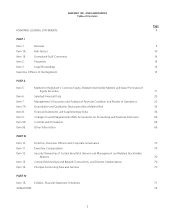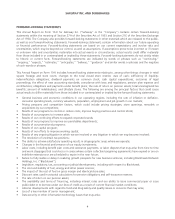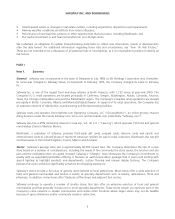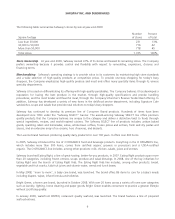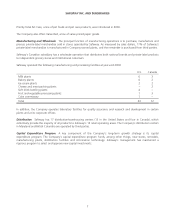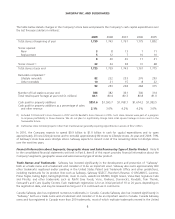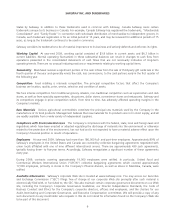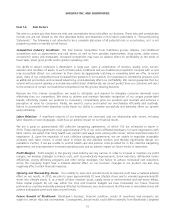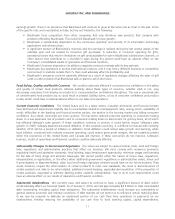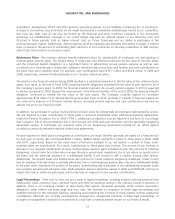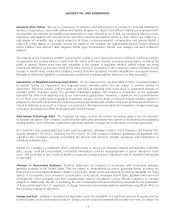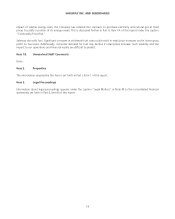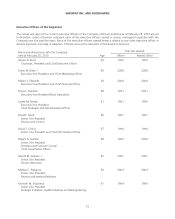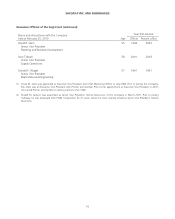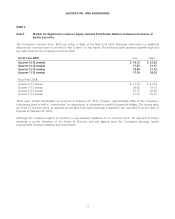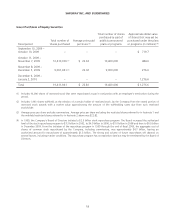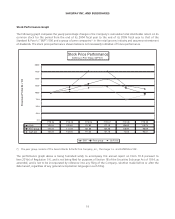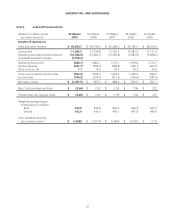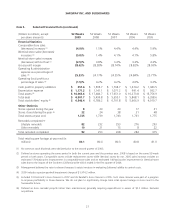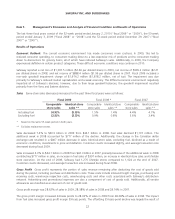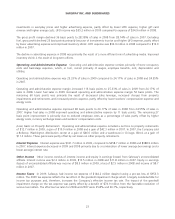Safeway 2009 Annual Report Download - page 31
Download and view the complete annual report
Please find page 31 of the 2009 Safeway annual report below. You can navigate through the pages in the report by either clicking on the pages listed below, or by using the keyword search tool below to find specific information within the annual report.SAFEWAY INC. AND SUBSIDIARIES
Insurance Plan Claims We use a combination of insurance and self-insurance to provide for potential liabilities for
workers’ compensation, automobile and general liability, property risk, director and officers’ liability and employee health
care benefits. We estimate the liabilities associated with the risks retained by us, in part, by considering historical claims
experience, demographic and severity factors and other actuarial assumptions which, by their nature, are subject to a
high degree of variability. Any actuarial projection of losses concerning workers’ compensation and general liability is
subject to a high degree of variability. Among the causes of this variability are unpredictable external factors affecting
future inflation rates, discount rates, litigation trends, legal interpretations, benefit level changes and claim settlement
patterns.
The majority of the Company’s workers’ compensation liability is from claims occurring in California. California workers’
compensation has received intense scrutiny from the state’s politicians, insurers, employers and providers, as well as the
public in general. Recent years have seen escalation in the number of legislative reforms, judicial rulings and social
phenomena affecting our business. Some of the many sources of uncertainty in the Company’s reserve estimates include
changes in benefit levels, medical fee schedules, medical utilization guidelines, vocation rehabilitation and apportionment.
Reversals of reforms by legislation or judicial action could have a material adverse impact on our financial results.
Impairment of Goodwill and Long-Lived Assets On our balance sheet, we have $426.6 million of goodwill subject
to periodic testing for impairment. Our long-lived assets, primarily stores, also are subject to periodic testing for
impairment. Failure to achieve sufficient levels of cash flow at reporting units could result in impairment charges on
goodwill and/or long-lived assets. Our goodwill impairment analysis also includes a comparison of the aggregate
estimated fair value of all reporting units to our total market capitalization. Therefore, a significant and sustained decline
in our stock price could result in goodwill impairment charges. During times of financial market volatility, significant
judgment is required to determine the underlying cause of the decline and whether stock price declines are short-term in
nature or indicative of an event or change in circumstances. We have incurred significant impairment charges to earnings
in the past, including fiscal 2009, for goodwill and long-lived assets.
Information Technology Risks The Company has large, complex information technology systems that are important
to business operations. The Company could encounter difficulties developing new systems or maintaining and upgrading
existing systems. Such difficulties could lead to significant expenses or losses due to disruption in business operations.
As a merchant who accepts debit and credit cards for payment, Safeway is subject to the Payment Card Industry Data
Security Standard (“PCI DSS”), issued by the PCI Council. PCI DSS contains compliance guidelines and standards with
regards to the Company’s security surrounding the physical and electronic storage, processing and transmission of
individual cardholder data.
Despite the Company’s considerable efforts and technology to secure our computer network and payment cardholder
data, security could be compromised, confidential information could be misappropriated or system disruptions could
occur. This could lead to loss of sales or profits or cause the Company to incur significant costs to reimburse third parties
for damages.
Changes in Accounting Guidance Financial statements are prepared in accordance with accounting principles
generally accepted in the United States. They are subject to interpretation by various governing bodies, including the
Financial Accounting Standards Board (“FASB”) and the SEC, which create and interpret accounting standards. For many
aspects of our business, such as workers’ compensation, store closures, employee benefit plans, goodwill and income tax
contingencies, these standards and their interpretations require management’s most difficult, subjective or complex
judgments. Additionally, the SEC is evaluating the use of International Financial Reporting Standards for the preparation
of financial statements by U.S. registrants. A change from current accounting guidance could have a significant effect on
the Company’s results of operations.
Energy and Fuel Safeway’s operations are dependent upon the availability of a significant amount of energy and fuel
to manufacture, store and transport products. Energy and fuel costs have experienced volatility over time. To reduce the
13


